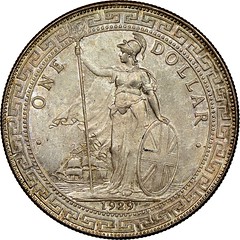
PREV ARTICLE
NEXT ARTICLE
FULL ISSUE
PREV FULL ISSUE
BRITANNIA'S EVOLUTIONLouis Golino published an article on World Mint News Blog about the evolution of the Royal Mint's Britannia. Here's an excerpt - see the complete article online. -Editor
Her roots are in the Roman conquest of Britain and the use of deities that began in ancient Greece and Rome that first personified concepts like Liberty with a female goddess called Libertas in Rome and Eleutheria in Greece.
Roman Britannia But it was later when Hadrian, who built his famous wall near the border between England and Scotland, that Roman influence increased in the area, which included the building of a shrine in York to Britannia depicted as a goddess. It was during this period (around 119 A.D.) that the first Roman coins were struck that featured a female figure who represented the personification of Britain and mentioned Britannia. And this Britannia of Roman coinage was based on the Roman goddess of wisdom, Minerva — a warrior-goddess who guided soldiers in battle and sported a helmet, spear, and shield, as has Britannia, for more than 2,000 years.
Britannia Revived On copper half pennies and farthings, Britannia was shown seated on a rock with an olive branch in her right hand and a spear in her left hand with a shield bearing the Union flag leaning against the rock.
The many different versions of her image over the centuries were clearly designed to convey that message that she is the stoic protector of the British nation and of the territorial integrity and security of Britain, but she also represents the British nation and people themselves and their history.
To read the complete article, see:
Wayne Homren, Editor The Numismatic Bibliomania Society is a non-profit organization promoting numismatic literature. See our web site at coinbooks.org. To submit items for publication in The E-Sylum, write to the Editor at this address: whomren@gmail.com To subscribe go to: https://my.binhost.com/lists/listinfo/esylum All Rights Reserved. NBS Home Page Contact the NBS webmaster 
|



